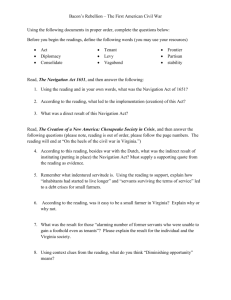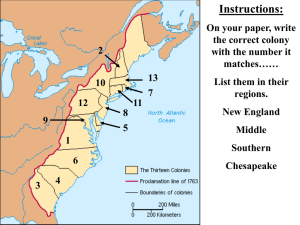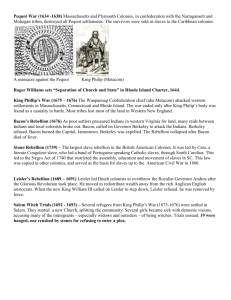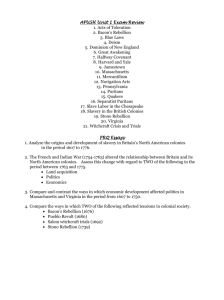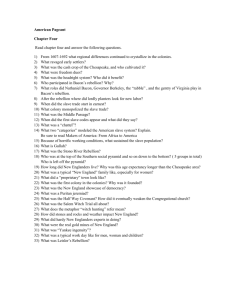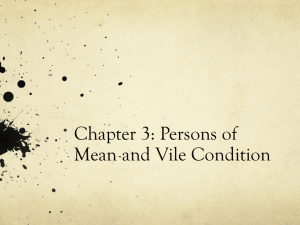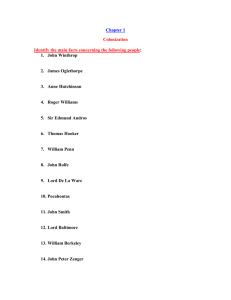journal 1 Lincoln Hirn
advertisement
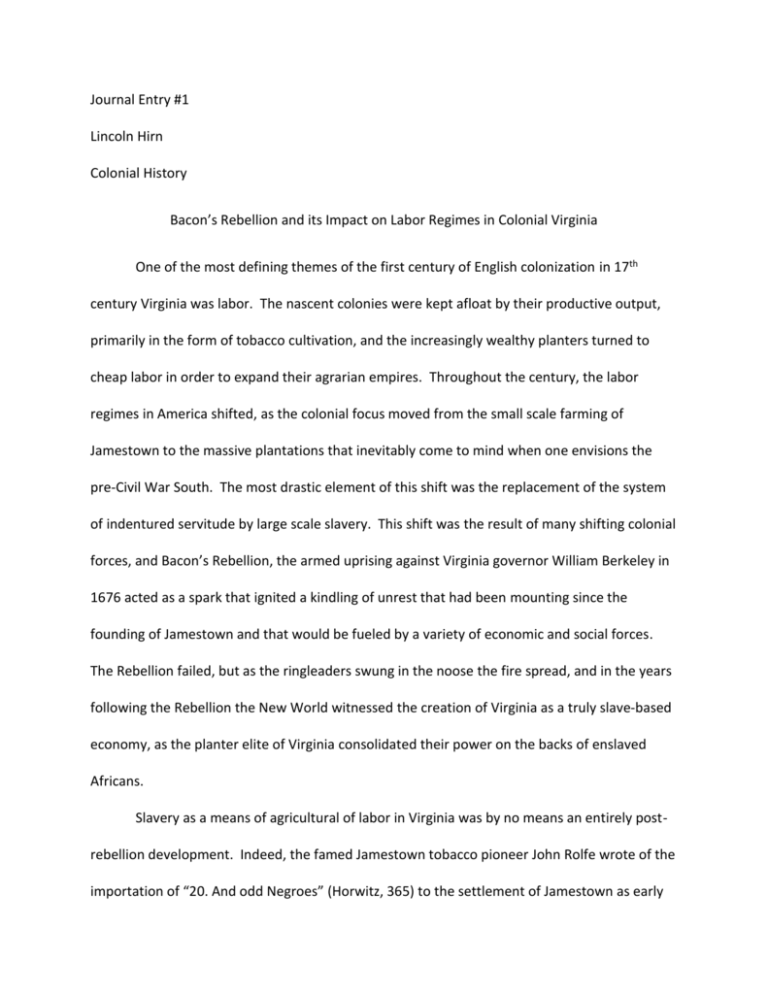
Journal Entry #1 Lincoln Hirn Colonial History Bacon’s Rebellion and its Impact on Labor Regimes in Colonial Virginia One of the most defining themes of the first century of English colonization in 17th century Virginia was labor. The nascent colonies were kept afloat by their productive output, primarily in the form of tobacco cultivation, and the increasingly wealthy planters turned to cheap labor in order to expand their agrarian empires. Throughout the century, the labor regimes in America shifted, as the colonial focus moved from the small scale farming of Jamestown to the massive plantations that inevitably come to mind when one envisions the pre-Civil War South. The most drastic element of this shift was the replacement of the system of indentured servitude by large scale slavery. This shift was the result of many shifting colonial forces, and Bacon’s Rebellion, the armed uprising against Virginia governor William Berkeley in 1676 acted as a spark that ignited a kindling of unrest that had been mounting since the founding of Jamestown and that would be fueled by a variety of economic and social forces. The Rebellion failed, but as the ringleaders swung in the noose the fire spread, and in the years following the Rebellion the New World witnessed the creation of Virginia as a truly slave-based economy, as the planter elite of Virginia consolidated their power on the backs of enslaved Africans. Slavery as a means of agricultural of labor in Virginia was by no means an entirely postrebellion development. Indeed, the famed Jamestown tobacco pioneer John Rolfe wrote of the importation of “20. And odd Negroes” (Horwitz, 365) to the settlement of Jamestown as early as 1619. While slavery has undoubtedly and inexcusably been a part of the Virginia agrarian culture since its inception, it was not always the most prominent form of coerced labor in the tobacco fields. Historian T.H. Breen writes that the solution to the demand for tobacco labor “In the middle of the 17th Century … was the importation of white indentured servants.” (Breen, 4) These laborers, who were usually white English immigrants, were not slaves, but they worked for no wages over a period of time specified by an indenture contract, which the servants would agree to in order to secure passage to the New World. As one might expect, this system of contractual bondage was the cause of a significant amount of strife, and both the masters and the servants voiced a multitude of grievances. Chief among the grievances for the masters was the quality of their laborers, and Breen again writes of the planters’ complaints of “indentured workers as a bunch of ‘desperate villans.’” (Breen, 5) The servants, who were predominantly young, poor men, griped as well, chafing in their bonds. Everything came to a head in 1676, when Nathaniel Bacon led a rebellion of disillusioned laborers, later described by Government representatives as “free men that had but lately crept out of the condition of Servants.” (Breen, 6) The rebellion, while initially successful, faltered after Bacon died of illness, and the remaining ringleaders were executed by Governor William Berkeley. The rebellion failed, but its indirect results continue to be felt today. Bacon’s Rebellion shook the Virginia aristocracy to its core. The unease that had been mounting for decades had finally combusted in the form of Nathaniel Bacon, and his coalition of laborers. Over the next decade, the planters’ mistrust of the servant class grew, but the class itself diminished, shrinking from a rather diverse group of white servants and black slaves, united by their bondage, to a group comprised solely of black slaves and this “Rapid shift from indentured to enslaved labor” (Tartar, 120) continues to define America today. This shift was by no means the result of the Rebellion alone, but it was certainly enhanced by the uprising. In the years following Bacon’s Rebellion, a slew of small-scale servant uprisings erupted, and the system of labor that had dominated Virginia for decades was suddenly thrown into disarray. The system, which “until the rebellion broke out in 1676 … had all seemed to work,” (Tartar, 108) had been irrevocably changed by Nathaniel Bacon. The aftermath of the rebellions coincided with developments in the methods used to transfer slaves to the Americas. These developments greatly increased the supply of slaves to the colony, allowing “Planters greater selectivity in the choice of servants.” (Breen, 14) Nathaniel Bacon had given the planters an excellent reason to eschew the labor practices of the past, and the new supply Nathaniel Bacon Image from: http://memory.loc.gov/ of slaves gave the planters a means to circumvent rebellious laborers. This shift from servitude to slavery not only worsened the already deplorable condition of blacks in Virginia, but enhanced the position of the planters, who now had permanent laborers whose arrival acted as essentially an enormous influx of capital for the elite. The new and massive system of slavery that had been birthed by the process of sweeping change kicked off by the Rebellion now allowed the planters to consolidate their wealth in the form of human property. By 1700, slavery had truly become the economic backbone of Virginia, creating a “Planters’ patriarchy that emerged into full flower in the decades following Bacon’s Rebellion.” (Tartar, 120) The remarkable change that occurred in Virginia over the relatively short period following Bacon’s Rebellion was the result of a myriad of forces from both the Old and New Worlds, but the era of transition can be traced back to 1676. The rebellion helped spark a defining shift in the way the Southern economy operated, creating a distinct class system of marked by the distinct characterization of the plantation masters and slaves who defined such a large swath of American history. Bacon’s Rebellion, in conjunction with a variety of changing cultural, economic, and social forces, helped to create one of the most impactful periods of change in early American history.

